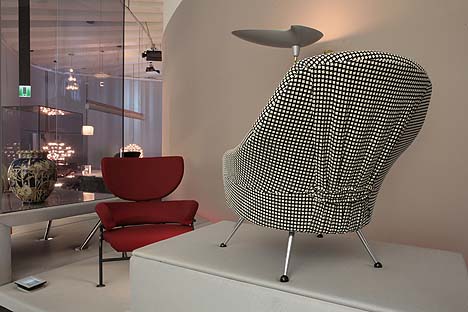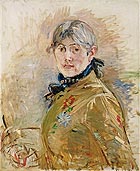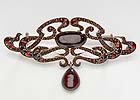
translated and summarized by: Liz Wollner-Grandville,
English summary April 14 - 21
MUMOK – Museum moderner Kunst
Exact and Different – Art and Mathematics from Dürer to Sol LeWitt
Abundant and unlimited
Art and mathematics are interesting and boundless topics. The MUMOK exhibit focuses on minimalist and conceptual art from the 60s, with excursions to classic Modernism – ranging from De Stijl, Bauhaus to Constructivism. If it weren’t for an exhibition like this one, 19th century mathematical models to which Max Ernst, Naum Gabo, Antoine Pevsner and Ruth Vollmer make reference in their works, would remain hidden to the public and doze away in university collections. Squares, numerical formats, or infinity – all of these themes are dealt with at this exhibit, something which could, however, also be done in an unmathematical manner. 18th century presentations of mirror-experiments have little to do with this and themes concerning geometric forms during Dürer’s era (with printing blocks of stunning aesthetic quality) would deserve their own exhibit.
MUMOK Museum moderner Kunst
1070 Vienna, Museumsquartier, until 18.05.08
www.mumok.at
Design Museum Milan
Divine design, deficient presentation
The location of Milan’s Design Museum is ideal. In the past years the renovated Palazzo Triennale has developed into an active cultural centre. Not only architecture-, design-, and photo exhibits as well as symposiums, book presentations, and seminars take place at the Palazzo, but it also accommodates a documentation centre as well as an extremely well assorted bookshop offering a fabulous choice of books on architecture, design and fine arts (probably the best in town). And to top the pleasantries of a visit off, you can enjoy a great dinner and a view over the Sempione Park.
The choice of works of the first presentation, to be seen until 2009, is however less satisfactory. In Italy’s capital of creativity and productivity, the abundance of ideas and products, which have significantly influenced the development of international design is amazing and seemingly endless, while the space in the new museum is, however, limited. And the main impression left by this presentation is that the main Italian design products are chairs. Admittedly they are important, but since the majority of the space available is filled with chairs, other design categories seem neglected.
Nevertheless, one can admire numerous examples of significant Italian design; and their impact is described by the motto printed on one of the museum’s walls: “Italian design creates what the market and the society is not yet acquainted with, but what they could become fond of”. Among these works are Giacomo Balla’s colourful vest made in 1924, making the close connection to Missoni obvious, the legendary “Vespa” (Corradion d’Ascanio, 1946), which accompanied Italy’s economic recovery after World War II, the portable featherweight Olivetti typewriter “Lettera 22” 1950, which excited Bert Brecht during his visit to Milan in February1956, the foldable and transparent plastic chair “Plia” (Giancarlo Pirretti for Castelli, 1968), the essential lamp “Parentesi” by Chille Castiglioni and Pio Manzú (1970), the Illy coffee cups by Matteo Thun (1980), and the anthropomorphic book shelf “Carlton” by Ettore Sottsass (1981 for Memphis).
Employing LED-monitors to replace normal lettering, however, went totally amiss: the small signs offer information about so many different pieces of art that you are forced to wait patiently until the description of the piece your are actually interested in finally appears.
DESIGN MUSEUM
Palazzo della Triennale
Vaile Alumina 6
Milan
www.triennale.it
Schirn Kunsthalle Frankfurt
Berthe Morisot, Mary Cassatt, Eva Gonzalés, Marie Bracquemond – Women Impressionists
Gender and genius
“Impressionism is feminine” – Frankfurt’s Schirn Halle is currently showing works created by the Impressionist painters Berthe Morisot, Mary Cassatt, Eva Gonzalés, and Marie Bracquemond. Have the art history books possibly missed out on the fact that towards the end of the 19th century art was also a woman’s matter?
Frankfurt definitely did not have to discover any of the four painters, as none of them had ever been forgotten. Berthe Morisot, sister-in-law and model for Edouard Manet, was a successful and admired colleague among the Impressionists. Just like Mary Cassatt; both created a monumental oeuvre during their time. Cassatt, in comparison to Morisot, did without her parent’s financial support and a marriage – all for the sake of artistic liberty and independence. Her graphics series, which was inspired by Japanese woodcarvings, represents one of the most interesting artistic chronicles of a woman’s everyday life towards the end of the 19th century. Eva Gonzales, Manet’s only female student, died at an early age and left an oeuvre of great quality. Marie Bracquemond was at the brink of abandoning her painting to work with her husband, the porcelain painter and graphic illustrator Felix Bracquemond. But her work impressed him and she continued.
If the show in Frankfurt would have abstained from using the feministic jargon of the 70’s, this could have turned out to be a delightful exhibition. After regarding Rosa Bonheur’s paintings, Empress Eugénie pointed out that “La genie n’a pas de sexe” – genius has no gender; and this was said an entire generation before the four women Impressionists were even discovered…
Schirn Kunsthalle Frankfurt
60311 Frankfurt am Main, Römberg, until 01.06.08
www.schirn.de
WAGNER:WERK Museum Postsparkasse
From Art Nouveau to Art Déco – The Turnov School of Jewellery and Gem Collection
Toads and cameos
Precious ornamental Art Nouveau figures were not only inspired by butterflies, dragonflies, and seahorses, but also by toads, moths, and beetles. The exhibit of the Turnov School of Jewellery and Gem Collection in the WAGNER:WERK Museum Postsparkasse displays impressive products dating from the turn of the century. The drafts and delicate designs of zoological and botanical themes enable the viewer to comprehend the stylization, abstraction, and finally the artistic transformation of these natural paragons.
The first European Institute of its kind was founded 1884 in Turnau (Turnov). Within a very short time the “k.u.k. Fachschule für das Schleifen und Fassen von Edelsteinen” (the royal school of applied arts for grinding and setting of gems) experienced a remarkable upswing and in 1904 at the World Expo in St. Louis, the Institute received two gold medals for a broche with Bohemian garnets. This piece of jewellery is also on display in Vienna.
In the centre of this Czech collection the development of formal art principles in Central Europe become obvious: commencing with solid Historicism, followed by Art Nouveau and Secession, Bohemian Cubism and Art Déco with French influences, to a kind of Neo-Historicism of the 40s. The school’s specialization on cutting stones implies that it focused on the ornamental setting of gems - garnets as well as rock crystals, cairngorm, jasper, and onyx-cameos.
WAGNER:WERK Museum Postsparkasse
1018 Wien, Georg-Coch-Platz 2, until 10.05.08
www.ottowagner.com
Mehr Texte von translated and summarized by: Liz Wollner-Grandville


 Teilen
Teilen




